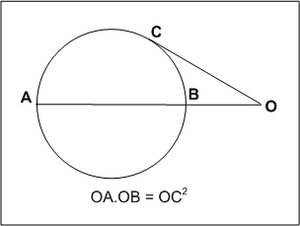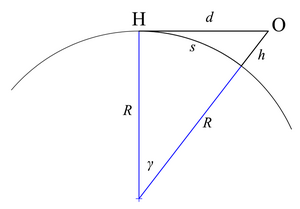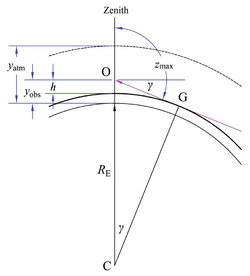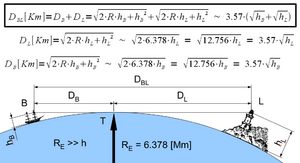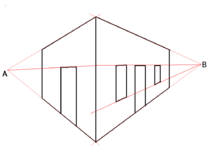أفق
The horizon is the apparent line that separates the surface of a celestial body from its sky when viewed from the perspective of an observer on or near the surface of the relevant body. This line divides all viewing directions based on whether it intersects the relevant body's surface or not.
The true horizon is actually a theoretical line, which can only be observed to any degree of accuracy when it lies along a relatively smooth surface such as that of Earth's oceans. At many locations, this line is obscured by terrain, and on Earth it can also be obscured by life forms such as trees and/or human constructs such as buildings. The resulting intersection of such obstructions with the sky is called the visible horizon. On Earth, when looking at a sea from a shore, the part of the sea closest to the horizon is called the offing.[1]
The true horizon surrounds the observer and it is typically assumed to be a circle, drawn on the surface of a perfectly spherical model of the Earth. Its center is below the observer and below sea level. Its distance from the observer varies from day to day due to atmospheric refraction, which is greatly affected by weather conditions. Also, the higher the observer's eyes are from sea level, the farther away the horizon is from the observer. For instance, in standard atmospheric conditions, for an observer with eye level above sea level by 1.70 metres (5 ft 7 in), the horizon is at a distance of about 5 kilometres (3.1 mi).[2] When observed from very high standpoints, such as a space station, the horizon is much farther away and it encompasses a much larger area of Earth's surface. In this case, the horizon would no longer be a perfect circle, not even a plane curve such as an ellipse, especially when the observer is above the equator, as the Earth's surface can be better modeled as an ellipsoid than as a sphere.
. . . . . . . . . . . . . . . . . . . . . . . . . . . . . . . . . . . . . . . . . . . . . . . . . . . . . . . . . . . . . . . . . . . . . . . . . . . . . . . . . . . . . . . . . . . . . . . . . . . . . . . . . . . . . . . . . . . . . . . . . . . . . . . . . . . . . . . . . . . . . . . . . . . . . . . . . . . . . . . . . . . . . . . .
الظهور والاستخدام
البعد عن الأفق
where h is height above sea level and R is the Earth radius.
When d is measured in kilometres and h in metres, the distance is
where the constant 3.57 has units of km/m½.
When d is measured in miles (statute miles i.e. "land miles" of 5,280 feet (1,609.344 m)[2]) and h in feet, the distance is
where the constant 1.22 has units of mi/ft½.
In this equation Earth's surface is assumed to be perfectly spherical, with r equal to about 6,371 kilometres (3,959 mi).
أمثلة
Assuming no atmospheric refraction and a spherical Earth with radius R=6,371 kilometres (3,959 mi):
- For an observer standing on the ground with h = 1.70 metres (5 ft 7 in), the horizon is at a distance of 4.7 kilometres (2.9 mi).
- For an observer standing on the ground with h = 2 metres (6 ft 7 in), the horizon is at a distance of 5 kilometres (3.1 mi).
- For an observer standing on a hill or tower 30 metres (98 ft) above sea level, the horizon is at a distance of 19.6 kilometres (12.2 mi).
- For an observer standing on a hill or tower 100 metres (330 ft) above sea level, the horizon is at a distance of 36 kilometres (22 mi).
- For an observer standing on the roof of the Burj Khalifa, 828 metres (2,717 ft) from ground, and about 834 metres (2,736 ft) above sea level, the horizon is at a distance of 103 kilometres (64 mi).
- For an observer atop Mount Everest (8,848 metres (29,029 ft) in altitude), the horizon is at a distance of 336 kilometres (209 mi).
- For an observer aboard a commercial passenger plane flying at a typical altitude of 35,000 feet (11,000 m), the horizon is at a distance of 369 kilometres (229 mi).
- For a U-2 pilot, whilst flying at its service ceiling 21,000 metres (69,000 ft), the horizon is at a distance of 517 kilometres (321 mi).
كواكب أخرى
Derivation
The secant-tangent theorem states that
Make the following substitutions:
- d = OC = distance to the horizon
- D = AB = diameter of the Earth
- h = OB = height of the observer above sea level
- D+h = OA = diameter of the Earth plus height of the observer above sea level,
with d, D, and h all measured in the same units. The formula now becomes
or
where R is the radius of the Earth.
- d = distance to the horizon
- h = height of the observer above sea level
- R = radius of the Earth
referring to the second figure at the right leads to the following:
The exact formula above can be expanded as:
where R is the radius of the Earth (R and h must be in the same units). For example, if a satellite is at a height of 2000 km, the distance to the horizon is 5,430 kilometres (3,370 mi); neglecting the second term in parentheses would give a distance of 5,048 kilometres (3,137 mi), a 7% error.
التقريب
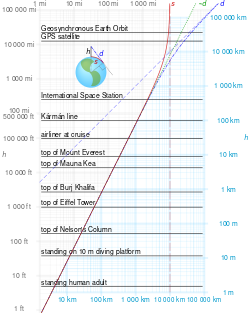
If the observer is close to the surface of the earth, then it is valid to disregard h in the term (2R + h), and the formula becomes-
Using kilometres for d and R, and metres for h, and taking the radius of the Earth as 6371 km, the distance to the horizon is
- .
Using imperial units, with d and R in statute miles (as commonly used on land), and h in feet, the distance to the horizon is
- .
If d is in nautical miles, and h in feet, the constant factor is about 1.06, which is close enough to 1 that it is often ignored, giving:
If h is significant with respect to R, as with most satellites, then the approximation is no longer valid, and the exact formula is required.
قياسات أخرى
Arc distance
then
Solving for s gives
The distance s can also be expressed in terms of the line-of-sight distance d; from the second figure at the right,
substituting for γ and rearranging gives
The distances d and s are nearly the same when the height of the object is negligible compared to the radius (that is, h ≪ R).
Zenith angle
where is the observer's height above the surface and is the angular dip of the horizon. It is related to the horizon zenith angle by:
For a non-negative height , the angle is always ≥ 90°.
Objects above the horizon
where DBL is in kilometres and hB and hL are in metres.
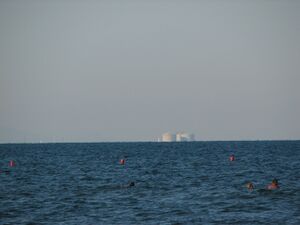
which comes to about 35 kilometres.
kilometres from him, which comes to about 11.3 kilometres away. The ship is a further 8.7 km away. The height of a point on the ship that is just visible to the observer is given by:
which comes to almost exactly six metres. The observer can therefore see that part of the ship that is more than six metres above the level of the water. The part of the ship that is below this height is hidden from him by the curvature of the Earth. In this situation, the ship is said to be hull-down.
. . . . . . . . . . . . . . . . . . . . . . . . . . . . . . . . . . . . . . . . . . . . . . . . . . . . . . . . . . . . . . . . . . . . . . . . . . . . . . . . . . . . . . . . . . . . . . . . . . . . . . . . . . . . . . . . . . . . . . . . . . . . . . . . . . . . . . . . . . . . . . . . . . . . . . . . . . . . . . . . . . . . . . . .
Effect of atmospheric refraction
where RE is the radius of the Earth, ψ is the dip of the horizon and δ is the refraction of the horizon. The dip is determined fairly simply from
where h is the observer's height above the Earth, μ is the index of refraction of air at the observer's height, and μ0 is the index of refraction of air at Earth's surface.
The refraction must be found by integration of
where is the angle between the ray and a line through the center of the Earth. The angles ψ and are related by
- Simple method—Young
A much simpler approach, which produces essentially the same results as the first-order approximation described above, uses the geometrical model but uses a radius R′ = 7/6 RE. The distance to the horizon is then[2]
Taking the radius of the Earth as 6371 km, with d in km and h in m,
with d in mi and h in ft,
Results from Young's method are quite close to those from Sweer's method, and are sufficiently accurate for many purposes.
Curvature of the horizon

Vanishing points
See also
References
Further reading
- Young, Andrew T. "Dip of the Horizon". Green Flash website (Sections: Astronomical Refraction, Horizon Grouping). San Diego State University Department of Astronomy. Retrieved April 16, 2011.






